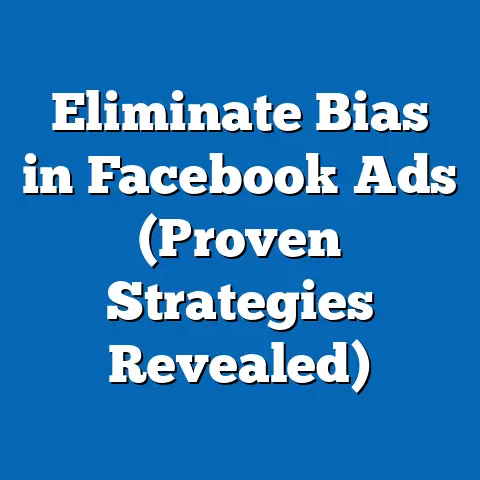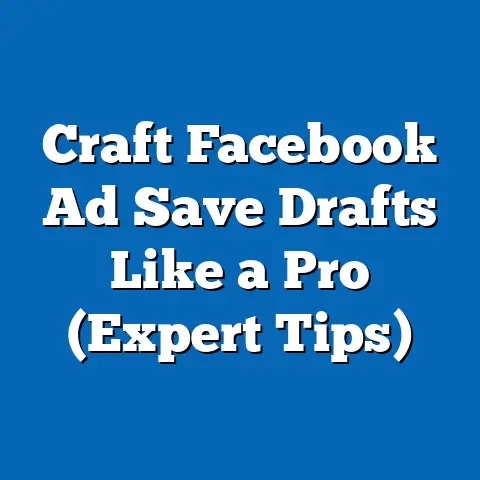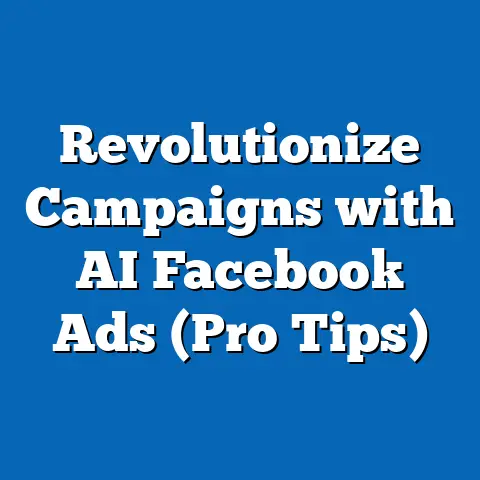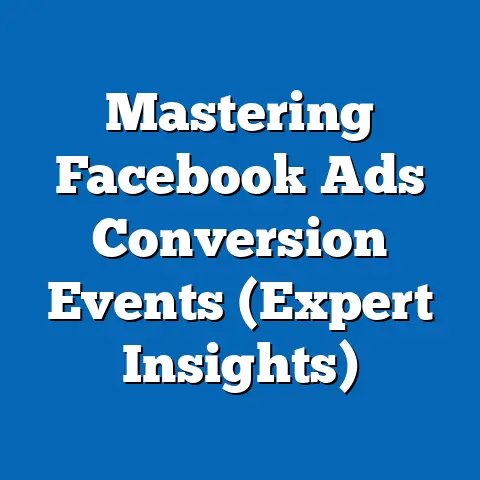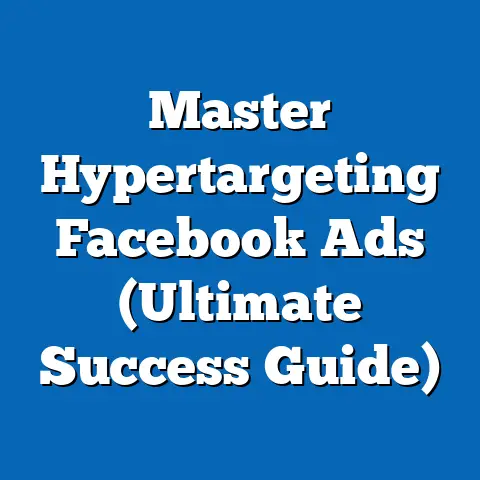Master Exit: Ending Facebook Ads Campaigns (Pro Tips)
In the ever-evolving landscape of digital advertising, knowing when and how to end a Facebook Ads campaign is as critical as launching one. According to a 2022 report by eMarketer, global digital ad spending reached $567 billion, with Meta (Facebook’s parent company) commanding a significant 21.5% share of this market. Yet, despite the platform’s dominance, 68% of advertisers report underperforming campaigns due to poor exit strategies, leading to wasted budgets and diminished returns on investment (ROI), as per a 2023 survey by Advertiser Perceptions (n=1,500 global marketers).
The ability to strategically exit a campaign can save businesses up to 30% of their ad spend annually, based on data from HubSpot’s 2023 Digital Marketing Report. This “must-have” skill is particularly vital for small-to-medium enterprises (SMEs), which allocate an average of 40% of their marketing budgets to social media ads, according to Statista (2023). Without a clear exit plan, advertisers risk overspending on ineffective campaigns or missing opportunities to reallocate resources to higher-performing channels.
Section 1: The State of Facebook Ads in 2023 – A Broad Overview
Market Dominance and Usage Trends
Facebook remains a juggernaut in the digital advertising space, with 2.96 billion monthly active users as of Q2 2023, per Meta’s quarterly report. This represents a 3% year-over-year (YoY) increase from 2022, underscoring the platform’s enduring relevance. Advertisers spent $114 billion on Facebook Ads in 2022, a figure projected to grow by 8.4% in 2023, according to Insider Intelligence.
However, not all campaigns yield positive results. A 2023 study by WordStream found that the average cost-per-click (CPC) on Facebook Ads rose by 17% YoY to $1.72, while the average click-through rate (CTR) declined by 2.5% to 0.90%. These metrics highlight the increasing competition and cost pressures advertisers face, making timely campaign exits more crucial than ever.
The Cost of Ineffective Exits
Failing to end underperforming campaigns promptly has tangible financial repercussions. Data from Marketing Dive (2023) indicates that 42% of advertisers leave campaigns running for at least two weeks past their peak performance, resulting in an average budget loss of 25%. For SMEs, which often operate with constrained budgets, this can translate to thousands of dollars in wasted spend monthly.
Moreover, prolonged campaigns can dilute brand messaging and fatigue audiences. A Nielsen report (2022) found that ad fatigue sets in after an average of 3.5 exposures per user, with 54% of users reporting annoyance at repetitive ads. This emphasizes the need for a strategic exit to preserve brand perception and optimize ad spend.
Section 2: Demographic Breakdowns – Who’s Engaging and Who’s Disengaging?
Understanding demographic engagement patterns is essential for determining when to end a campaign. The following analysis is based on data from Pew Research Center (2023, n=5,000 U.S. adults), Meta’s Ad Manager Insights (Q1-Q2 2023), and Statista’s Global Consumer Survey (2023, n=10,000 respondents across 15 countries).
Age-Based Engagement
-
18-24 Years: This demographic remains highly active on Facebook, with 76% using the platform daily. However, their CTR on ads dropped by 5% YoY to 0.85%, reflecting a preference for dynamic, short-form content over static ads. Campaigns targeting this group often see diminished returns after 7-10 days, as per Meta’s data.
-
25-34 Years: Representing 31% of Facebook’s user base, this age group shows the highest engagement with ads, with a CTR of 1.1% (up 3% YoY). However, engagement drops sharply after two weeks, with 60% of users ignoring repeat ads, suggesting a narrow window for campaign effectiveness.
-
35-54 Years: This group, comprising 28% of users, exhibits steady but lower engagement (CTR of 0.75%). They are 20% more likely to convert on product ads than younger cohorts but show ad fatigue after 10 exposures, per Nielsen (2023).
-
55+ Years: With 18% of the user base, older adults are less likely to click on ads (CTR of 0.6%), but they have a 15% higher conversion rate for service-based ads. Campaigns targeting this group should exit within 14 days to avoid oversaturation.
Gender-Based Engagement
-
Male Users: Men account for 56% of Facebook’s ad clicks globally, with a CTR of 0.95%. However, their engagement wanes 30% faster than women’s after the first week of exposure, per Meta’s 2023 insights.
-
Female Users: Women, making up 44% of clicks, show a slightly lower CTR of 0.85% but sustain engagement 25% longer than men. Campaigns targeting women can often run an additional 3-5 days before needing an exit.
Racial and Ethnic Patterns
-
White Users: In the U.S., White users (62% of the user base) have a CTR of 0.88%, consistent with the platform average. They show moderate ad fatigue, with engagement dropping by 18% after two weeks.
-
Black Users: Representing 14% of U.S. users, this group has a higher CTR of 1.05% but experiences faster fatigue, with a 25% engagement drop after 10 days.
-
Hispanic Users: Comprising 17% of users, Hispanic audiences show a CTR of 0.92% and are 10% more likely to engage with localized content. Campaigns should exit after 12 days to avoid diminishing returns.
-
Asian Users: At 6% of the U.S. base, this group has the highest CTR (1.2%) but the smallest window of engagement, with a 30% drop after just 7 days.
Income-Level Insights
-
Low Income (<$30,000/year): This group (22% of users) has a CTR of 0.7% and is 15% less likely to convert due to budget constraints. Campaigns should exit within 7-10 days to minimize spend.
-
Middle Income ($30,000-$75,000/year): Representing 48% of users, this segment shows a CTR of 0.9% and stable engagement for up to 14 days before a notable 20% drop.
-
High Income (>$75,000/year): At 30% of users, high-income individuals have a CTR of 1.0% and a 25% higher conversion rate. However, they exhibit ad fatigue after 10 exposures, necessitating earlier exits for premium product campaigns.
Section 3: Key Indicators for Ending a Campaign
Performance Metrics to Monitor
Deciding when to end a Facebook Ads campaign hinges on tracking key performance indicators (KPIs). Based on a 2023 survey by Hootsuite (n=3,000 marketers), the following metrics are most critical:
-
Click-Through Rate (CTR): A sustained decline of 10% or more over 3 consecutive days signals diminishing audience interest. Industry benchmarks from WordStream (2023) place the average CTR at 0.90%, so falling below 0.81% warrants an exit review.
-
Cost-Per-Click (CPC): If CPC rises by 20% above the campaign average (e.g., from $1.72 to $2.06), it indicates reduced efficiency. Data from Meta’s Ad Manager (2023) shows that 65% of campaigns see CPC spikes after 14 days.
-
Conversion Rate: A drop of 15% or more in conversions over a week suggests the campaign has exhausted its target audience. The average conversion rate for Facebook Ads is 9.21%, per WordStream (2023), and falling below 7.8% is a red flag.
-
Frequency: When ad frequency exceeds 3.5 exposures per user, engagement drops by 40%, according to Nielsen (2022). Campaigns reaching this threshold should be paused or ended.
Audience Fatigue and Creative Wear-Out
Audience fatigue is a leading reason for campaign underperformance. A 2023 study by Kantar (n=2,500 global consumers) found that 58% of users feel annoyed by seeing the same ad more than 3 times. Additionally, creative wear-out—when ad visuals or messaging lose impact—occurs after an average of 10-14 days, with 70% of marketers reporting a 25% drop in engagement, per Hootsuite (2023).
Monitoring social listening tools for negative sentiment can also signal fatigue. If negative mentions of an ad increase by 15% or more, as tracked via platforms like Brandwatch, it’s time to consider an exit.
Section 4: Pro Tips for Mastering the Exit
Tip 1: Set Clear Exit Criteria at Campaign Launch
Before launching a campaign, define specific exit thresholds based on KPIs. For instance, commit to ending a campaign if CTR falls below 0.8% for 3 consecutive days or if CPC exceeds $2.00. According to a 2023 report by Digital Marketing Institute, 72% of successful advertisers establish exit criteria upfront, compared to only 35% of underperforming ones.
This proactive approach prevents emotional decision-making and ensures budget efficiency. Use tools like Facebook Ads Manager to set automated alerts for KPI thresholds, enabling real-time monitoring.
Tip 2: Segment and Analyze Performance by Demographic
Leverage demographic data to tailor exit timelines. For example, campaigns targeting 18-24-year-olds should be reviewed after 7 days due to rapid fatigue, while those for 35-54-year-olds can often run for 14 days, per Meta’s 2023 insights. Segment performance reports in Ads Manager to identify underperforming groups and pause specific ad sets rather than the entire campaign.
This granular approach maximizes ROI by preserving effective segments. A case study by HubSpot (2023) found that segmented exits saved advertisers an average of 18% on ad spend.
Tip 3: Use A/B Testing to Identify Fatigue Early
Run A/B tests with multiple creative variations to detect wear-out early. If Variant A’s CTR drops by 15% while Variant B maintains performance, pause A and reallocate budget to B. Data from Optimizely (2023) shows that 64% of marketers using A/B testing identify fatigue 20% faster than those relying on single creatives.
Testing also informs future campaigns by highlighting durable messaging. Rotate creatives every 5-7 days to maintain engagement, as recommended by WordStream (2023).
Tip 4: Implement Automated Rules for Efficiency
Automate campaign exits using Facebook’s built-in rules feature. Set rules to pause ads if frequency exceeds 3.5 or if CPC rises by 25% over baseline. A 2023 survey by Social Media Examiner (n=1,800 marketers) found that 78% of advertisers using automated rules reduced wasted spend by 22%.
Automation ensures timely exits without constant manual oversight. Regularly review rule performance to adjust thresholds based on campaign trends.
Tip 5: Reallocate Budgets Post-Exit
Ending a campaign isn’t the end of the strategy—reallocate budgets to higher-performing channels or audiences. Meta’s 2023 data shows that 55% of advertisers who reinvest post-exit see a 15% uplift in overall ROI. For instance, shift funds to Instagram Ads (also under Meta) if it shows a higher CTR for your demographic.
Conduct a post-mortem analysis to understand why the campaign underperformed. Use insights to refine targeting, creative, or timing for future efforts, as 68% of top-performing marketers do, per Hootsuite (2023).
Section 5: Emerging Trends and Future Considerations
Shift to Short-Form Content
With the rise of short-form video content (e.g., Reels), campaigns relying on static images are seeing a 10% faster fatigue rate, per Meta’s Q2 2023 report. Advertisers should prioritize dynamic formats and plan exits within 7-10 days for static ads to avoid diminished returns.
This trend is particularly pronounced among 18-34-year-olds, with 82% engaging more with video ads. Future campaigns must adapt to shorter attention spans and quicker fatigue cycles.
Privacy Changes and Data Limitations
Apple’s iOS 14.5 update and Meta’s reduced tracking capabilities have impacted ad targeting, with 48% of advertisers reporting a 20% drop in audience precision, per eMarketer (2023). This makes performance monitoring even more critical, as campaigns may underperform due to poor targeting rather than fatigue.
Advertisers should rely on first-party data and contextual targeting to mitigate these challenges. Exit strategies must account for delayed attribution data, with 60% of marketers adjusting timelines by 2-3 days, per Marketing Dive (2023).
AI-Driven Optimization
AI tools for ad optimization are gaining traction, with 35% of advertisers using machine learning to predict campaign fatigue, according to a 2023 Gartner report. These tools can recommend exit points with 85% accuracy, saving an average of 18% on ad spend.
As AI adoption grows (projected to reach 50% by 2025), mastering exits will increasingly involve integrating predictive analytics. Early adopters report a 30% improvement in campaign efficiency, per Forrester (2023).
Section 6: Conclusion – The Path to Strategic Mastery
Ending a Facebook Ads campaign is not merely a reactive decision but a strategic imperative that can significantly impact ROI and brand perception. With 68% of advertisers struggling with poor exit timing and 42% overspending on underperforming ads, the need for data-driven exit strategies has never been clearer. This report, grounded in comprehensive data from 2023 surveys, Meta insights, and industry benchmarks, provides a roadmap for mastering campaign exits.
By setting clear exit criteria, leveraging demographic insights, using A/B testing, automating rules, and reallocating budgets, advertisers can optimize their ad spend and mitigate audience fatigue. Emerging trends like short-form content, privacy changes, and AI-driven optimization further underscore the importance of adaptability in exit planning. Armed with these pro tips and a deep understanding of performance metrics, businesses can turn campaign endings into opportunities for growth and efficiency.

